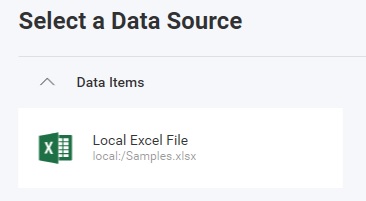Adding an Excel File Data Source
Step 1 - Create a folder that will contain your Excel files

Make sure to set the "Copy to Output Directory" property of the Excel files to "Copy Always" or "Copy if Newer" in the Visual Studio Properties window.
Step 2 - Set the RevealSdkSettings.LocalDataFilesRootFolder property to the location of the folder created in Step 1
RevealSdkSettings.LocalDataFilesRootFolder = Path.Combine(Environment.CurrentDirectory, "Data");
This instructs the Reveal SDK to use this location to load any files bing used as a file-based data source.
Step 3 - Add an event handler for the RevealView.DataSourcesRequested event.
<rv:RevealView x:Name="_revealView" DataSourcesRequested="RevealView_DataSourcesRequested" />
In the event handler, define two collections; one for the data sources, and one for the data source items. These two collections are used a parameters to the RevealDataSources object which is required in the event handler callback.
private void RevealView_DataSourcesRequested(object sender, Reveal.Sdk.DataSourcesRequestedEventArgs e)
{
var dataSources = new List<RVDashboardDataSource>();
var items = new List<RVDataSourceItem>();
...
e.Callback(new RevealDataSources(dataSources, items, true));
}
Step 4 - In the RevealView.DataSourcesRequested event handler, create a new instance of the RVLocalFileDataSourceItem object. Set the Uri property to the path, including the file name, of the Excel file you want to use as a data source.
private void RevealView_DataSourcesRequested(object sender, Reveal.Sdk.DataSourcesRequestedEventArgs e)
{
var dataSources = new List<RVDashboardDataSource>();
var items = new List<RVDataSourceItem>();
var localFileItem = new RVLocalFileDataSourceItem();
localFileItem.Uri = "local:/Samples.xlsx";
e.Callback(new RevealDataSources(dataSources, items, true));
}
You must prefix the Excel file path with local:/, because this instructs the Reveal SDK to load files using the RevealSdkSettings.LocalDataFilesRootFolder as the root of the file path. If you have subfolders within the root path, be sure to include these subfolders in the Uri property.
For example:
- Without subfolder -
RVLocalFileDataSourceItem.Uri = "local:/FileName.xlsx" - With subfolder -
RVLocalFileDataSourceItem.Uri = "local:/SubFolder/FileName.xlsx"
Step 5 - Create a new instance of the RVExcelDataSourceItem object and pass the RVLocalFileDataSourceItem instance you created in the previous step as an argument in the object constructor. Set the Title property to a string which describes the data within the Excel file.
Finally, add the RVExcelDataSourceItem object to the data source items collection.
private void RevealView_DataSourcesRequested(object sender, Reveal.Sdk.DataSourcesRequestedEventArgs e)
{
var dataSources = new List<RVDashboardDataSource>();
var items = new List<RVDataSourceItem>();
var localFileItem = new RVLocalFileDataSourceItem();
localFileItem.Uri = "local:/Samples.xlsx"; // "local:/" is a required prefix
var excelDataSourceItem = new RVExcelDataSourceItem(localFileItem);
excelDataSourceItem.Title = "Local Excel File";
items.Add(excelDataSourceItem);
e.Callback(new RevealDataSources(dataSources, items, true));
}
When the application runs, create a new Visualization and you will see the newly created Excel file data source listed in the "Select a Data Source" dialog.

The source code to this sample can be found on GitHub.